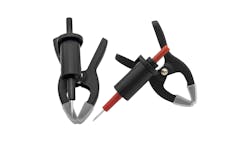Content brought to you by PTEN. To subscribe, click here.
Q: How did the tool function as far as saving you time?
A: This is a very unique tool. It’s a couple of spring-loaded electrical probes attached to clamps. You can attach the clamps close to whatever you are trying to check, and the spring-loaded probe stays in place. This saves the time and hassle of trying to figure out how to keep the probe where you need it, and quite possibly frees up your hands.
Q: How easy was it to use?
A: Very easy to use. The clamps are a squeeze type clamp, so you just squeeze them open and clamp them onto whatever is close to where you need to test. The probes themselves are spring-loaded to maintain contact with whatever you are testing.
Q: How was its packaging?
A: The packaging is actually very nice. The clamps are in a form-fit plastic sleeve with a cardboard backing. You simply remove a couple of staples, slide the cardboard out and you are ready to go. They are easy to put back in the package if you want to store them that way.
Q: Was there a manual included?
A: There was no manual included. There were some pictures of the clamps in use on the cardboard backplate. If you couldn’t figure out how to use them, you probably shouldn’t be working on electrical systems.
Q: What features did you like?
A: I really like that the probes are pointed on the end, and spring-loaded. This works great for maintaining contact with whatever you are trying to test. They also swivel on the clamps, so you don’t have to be directly in line with your intended target. The probes also have a 4mm female end on them which seems to be the standard for most test leads.
Q: Is there any way you could think to improve or add to this tool?
A: The clamps themselves are made from some sort of plastic or composite material. I understand the thought process around electrical equipment but wonder if insulated metal might hold up better. Additionally, the probe swivels in one direction on the clamp. There were times when it would have been nice to be able to change the angle in the other direction as well. Maybe a ball and socket attachment instead of a single swivel joint.
Q: What types of jobs/repairs did you use this tool for?
A: I used the probes for electrical circuit testing under the hood and in the passenger compartment. They were handy when checking circuits originating from the fuse panel. They also worked well in making a good ground for circuit checking. With a long test lead, they work well for testing from one end of the vehicle to the other.
Q: Have you used a previous version of this tool?
A: I have used various probes before, but never any attached to clamps. These were handy in several instances.
Q: On a scale of 1 to 10, how would you rate this tool overall? Why?
A: A solid nine. They are very nice, and something different than I had ever used before.
The Tool Aid Clamp Probe Set, No. 21200, was originally designed to allow a lone technician to test for voltage drop on top battery posts, but its handsfree operation is a useful diagnostic tool when a third hand is needed. The probe, under spring tension, adjusts in height within the housing, and rotates 360 degrees so users can test where they need to. The probes accept a standard 4mm banana plug, allowing technicians to use their existing equipment. The Clamp Probes are also available individually as the 21215 (black) and 21216 (red).
About the Author

Randy Kaiser
Randy Kaiser started working at Rost Motor, Inc. shortly after graduating high school, and he is still working there 48 years later. Through the years, he has been a lube tech, line tech, paint and body tech, parts department head, service manager, and is currently in charge of the parts and service departments. Kaiser is ASE Master Certified and a Ford Master Certified Technician, as well as a Ford certified Service Manager and Service Advisor.
Kaiser also reviews a variety of tools for Professional Tool & Equipment News. To read his tool reviews, search his name on VehicleServicePros.com.
